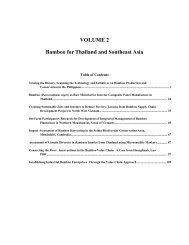WBC-VIII-Vol.4 – Resources – Forestry, Plantations and ... - BambuSC
WBC-VIII-Vol.4 – Resources – Forestry, Plantations and ... - BambuSC
WBC-VIII-Vol.4 – Resources – Forestry, Plantations and ... - BambuSC
Create successful ePaper yourself
Turn your PDF publications into a flip-book with our unique Google optimized e-Paper software.
Effects of Bamboo Plantation on Soil Al Forms<br />
Aluminum in soil includes mineral <strong>and</strong> aqueous forms, where Al minerals are mainly primary <strong>and</strong> secondary<br />
minerals such as aluminosilicate <strong>and</strong> non-aluminosilicate Al. According to its bound form with minerals, soil<br />
mineral Al can be classified as exchangeable Al, hydroxide bound Al, organic complexed Al, hydroxide Al <strong>and</strong><br />
non-crystalline aluminosilicate Al. Water soluble Al includes dissociated Al, mono-nuclear hydroxide Al, multinucleus<br />
hydroxide Al, Al-F, Al2(SO4)3 <strong>and</strong> organic complexed Al. Soil Al chemical forms are comlicate in soils<br />
that depends on the environment, especially on soil pH value. When pH is less than 5, Al is mainly present in<br />
Al 3+ form. When pH increases, Al(OH) 2+ <strong>and</strong> Al(OH)2 + occurs. When pH is equal to 7, Al will be present in<br />
Al(OH)3 or gibbsite. Under the alkaline condition, Al(OH)4 - or aluminosilicate is present. Mono Al ion can be<br />
complexed with inorganic lig<strong>and</strong>s, such as PO4 3- , SO4 2- , F - , organic acid, protein or adipose. The toxicity of<br />
various Al forms on plant is different. Relatively, the toxicity of various Al forms show an order as: Al 3+ ><br />
Al(OH) 2+ > Al(OH)2 + > F-Al >>organic complexed Al.<br />
Because soil Al form is closely related to soil pH <strong>and</strong> organic matter, the change of pH <strong>and</strong> organic matter will<br />
result in a great change of soil Al form <strong>and</strong> distribution pattern. As shown in Table 2, the total soil Al content in<br />
the surface layer (0-25 cm) decreased in the bamboo plot significantly but the exchangeable Al content<br />
increased greatly from 3.85 mg kg -1 to 197.6 mg kg -1 compared with the paddy soil. The extracted amorphous<br />
Al, dissociation Al <strong>and</strong> organic bound Al also increased significantly in the bamboo plot. Soil Al dissociation<br />
degree (Ald/AlT) <strong>and</strong> activation degree (Alo/Ald) both increased as well. Accordingly, the bamboo plantation<br />
greatly increased the solubility <strong>and</strong> movement of Al that exert an extreme toxic risk on bamboo growth.<br />
Possibly, the improved soluble Al affected the bamboo shoot <strong>and</strong> resulted in a yield drop. Due to fixation with<br />
soil solid phase or phosphate, the concentration of Al in soil solution is generally very low that has little effect<br />
on plant growth. However, when soil pH is lower than 4.5, Al will release substantially from bound form to<br />
soluble form <strong>and</strong> be harmful to plant growth. As pointed out, plant root growth <strong>and</strong> development is the primary<br />
target of Al toxicity (Sivaguru <strong>and</strong> Horst 1999; Vebelen et al. 2006). When soil soluble Al concentration<br />
arranges 10 to 20 mg kg -1 , plant will appear obvious harmful diagnosis (Shen <strong>and</strong> Yan 2002). There is no<br />
evidence to indicate the tolerance extent of Lei bamboo. Factually, the bamboo shoot production decreased<br />
significantly <strong>and</strong> inferred that Al toxicity might mainly responsible for the yield decline.<br />
The bamboo plantation greatly influenced soil Al distribution pattern in the profile (Fig. 2). In the paddy soil,<br />
soil total Al distributed evenly in the layer of 0-25 cm, while it increased with increasing soil depth in the<br />
bamboo soils (the 15 th year). As indicated in Table 2, the total Al content is lower in the bamboo plot than that<br />
of paddy plot, suggesting the current bamboo plantation management also improved Al leached from the surface<br />
layer.<br />
Soil Properties <strong>and</strong> Al Form Transformation<br />
Soil Al forms are influenced greatly by the other soil basic properties. Al dissolved from the minerals to soluble<br />
phase is determined by the system pH. We can find out clearly that the content of exchangeable Al exponential<br />
decreased with increasing pH within the pH segment of 3 to 6 (Fig. 3). This result is well consistent to that<br />
explained by the physicochemical computation. From the Table 2, no linear relationship existed among the pH<br />
<strong>VIII</strong> World Bamboo Congress Proceedings Vol 4-61




